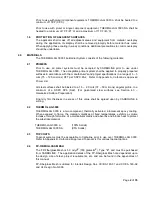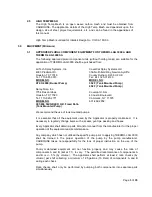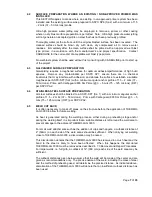
Page
12
of
35
8.1
INTRODUCTION
THERMO-LAG 3000 lends itself to being a material which can be applied off site and later
shipped to the job site. This allows for a more consistent application of the material off site
and elimination of interference with other trades which may affect application flow. When
this type of application is performed, contact CARBOLINE for advice. In general, the
application of THERMO-LAG 3000 follows the guidelines in this manual. The following
additional requirements are necessary:
8.2
BLOCK OUT AREAS
Prior to application of the shop fireproofing, define all areas of the steel structures that do
not receive THERMO-LAG 3000 until after the erection phase of the construction. These
areas which are not to receive THERMO-LAG 3000 shall be masked off in the proper
dimensions, prior to application. The size of the block out shall be determined by the
applicator, owner or engineering firm. THERMO-LAG 3000 has high bond strength, and
cannot be easily removed. For in shop application, the specified topcoat system shall be
applied to all THERMO-LAG 3000 surfaces. After steel is erected, the topcoat shall be
mechanically removed from the edges and back approximately 1” from the edge of the block
out.
Application to the block out areas may now continue, utilizing spray or trowel methods. The
THERMO-LAG 3000 finish appearance must be approved by the owner.
The specified mesh type shall be installed and butted up to the existing mesh (no overlap
required). The final specified thickness of THERMO-LAG 3000 can then be applied.
The blocked out edges can be left as butt joints to a 90 degree angle or beveled to a 45
degree angle.
The specified topcoat system shall be applied, based on the original specification, in strict
accordance with Carboline’s written instructions.
8.3
HANDLING, STORAGE AND ERECTION
8.3.1
UNLOADING
Generally the fireproofed steel is loaded and unloaded with a crane to permit maximum
loading of each truck. It is not advisable to unload fireproofed steel with forklifts, as the steel
is nested in ways that forklifts do not easily accommodate and damage to fireproofing may
occur.
8.3.2
RIGGING
Wherever possible, steel should not be rigged to the fireproofed portion of the member.
Shackles at end holes are a generally acceptable practice and provide the best method for
unloading members. Follow all site specific safety standards for handling structural steel.
8.4
DUNNAGE
Members should be stored on proper dunnage (on the block out areas) to avoid exposure to
the ground and moisture.
8.4.1
ORIENTATION OF MEMBERS
Members should be stacked with webs vertical to avoid ponding of water and snow. Elevate
one end of the steel member to provide water run off.
8.4.2
STACKING
Where members must be double stacked, avoid placing dunnage on the fireproofed
surfaces.
8.5
RIGGING
Содержание Thermo-Lag 3000
Страница 21: ...Page 14 of 35 APPENDIX A THERMO LAG 3000 ACCEPTABLE PRIMER LIST...
Страница 23: ...Page 16 of 35 APPENDIX B THERMO LAG 3000 ACCEPTABLE TOPCOAT LIST...
Страница 25: ...Page 18 of 35 APPENDIX C THERMO LAG 3000 ASTM E119 DESIGNS...
Страница 38: ...Page 31 of 35 APPENDIX D THERMO LAG 3000 TYPICAL APPLICATION LOGS...
Страница 40: ...Page 33 of 35...
Страница 41: ...Page 34 of 35...
Страница 42: ...Page 35 of 35...
















































